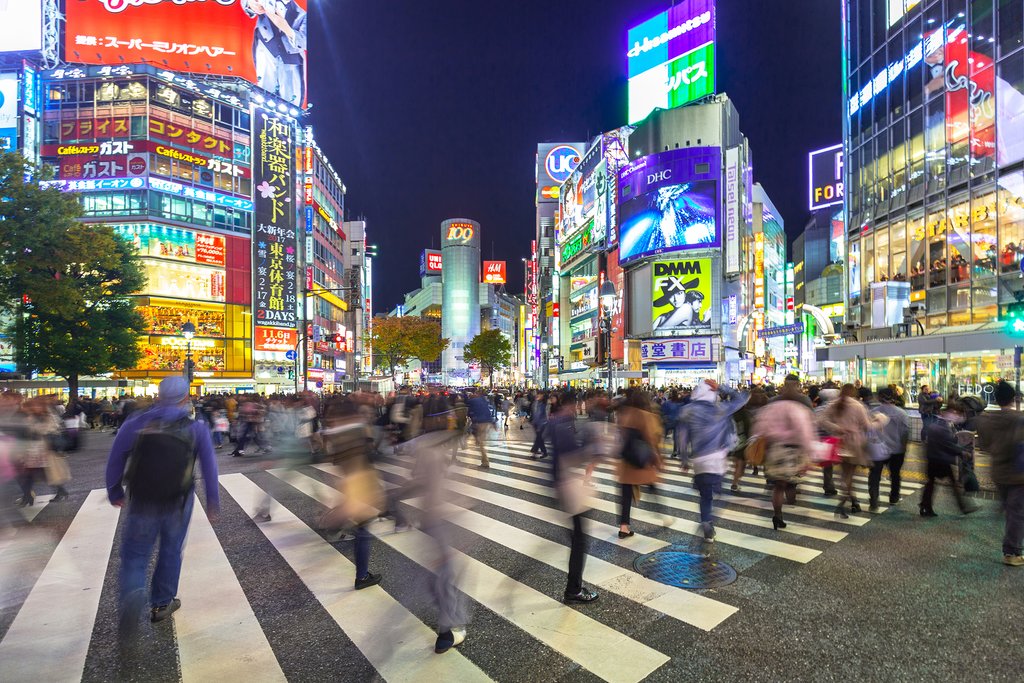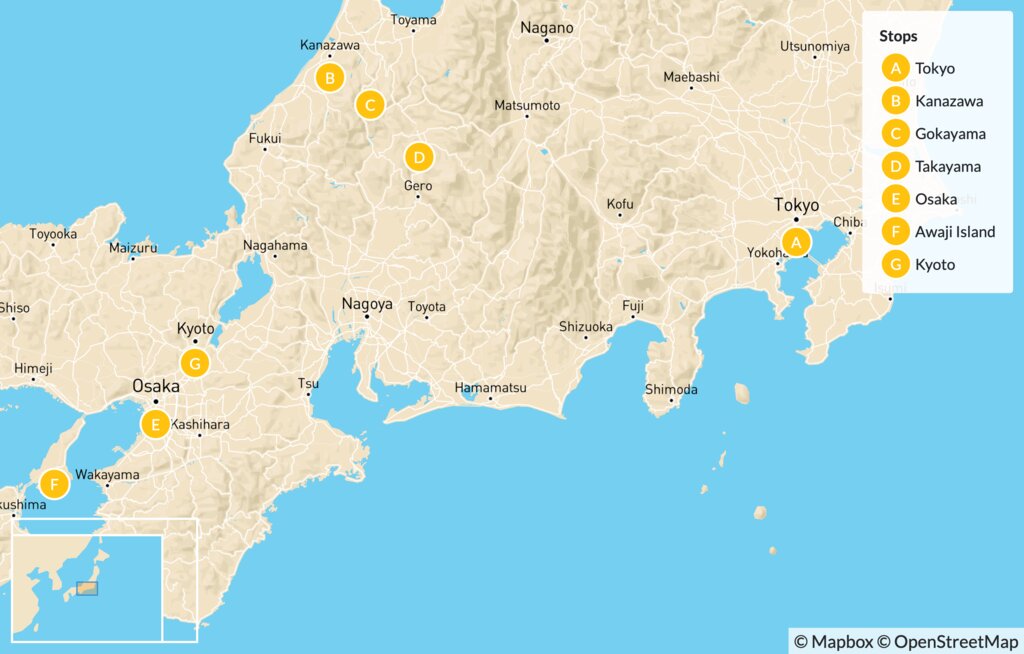
Japan's Culinary Heritage - 11 Days

Highlights
- Forage for vegetables and learn to cook regional dishes
- Learn the ancient art of earth oven cooking from a local villager
- Snack on delicious street food and sample locally brewed sake
- Appreciate the artistry of a "foodscape" on Awaji Island
- Enjoy a private gourmet meal prepared by a master chef
Brief Itinerary
| Day | Highlights | Overnight |
|---|---|---|
| Day 1 | Arrive in Tokyo | Tokyo |
| Day 2 | Train to Kanazawa, Visit Omicho Market | Kanazawa |
| Day 3 | Bus to Gokayama, Foraging Experience & Doburoku Sake Tasting | Gokayama |
| Day 4 | Transfer to Takayama via Shirakawa-go | Takayama |
| Day 5 | Day Trip to Hida Furukawa: Classic Earth Oven Cooking Experience | Takayama |
| Day 6 | Train to Osaka, Sake Tasting | Osaka |
| Day 7 | Day Trip to Asuka: Farm-to-Table Cooking Experience | Osaka |
| Day 8 | Transfer to Awaji Island, Foodscape Experience | Awaji Island |
| Day 9 | Train to Kyoto, Nishiki Market & Gion District | Kyoto |
| Day 10 | Explore Kyoto & Kaiseki Farewell Dinner | Kyoto |
| Day 11 | Depart Kyoto |
Detailed Itinerary
Day 1: Arrive in Tokyo

Get ready for an unforgettable culinary adventure! Upon arriving in Tokyo, meet your guide at your hotel in the center of the city. After settling in, you'll hit the bustling streets, where your guide will help you navigate the tastiest options for food and drink beneath those famous neon lights. Make like a local and join the post-work crowd at an izakaya or casual gastropub. These popular bars offer a combination of small plates and alcohol and are generally found clustered around train stations. Complement your meal with a sampling of Japanese beers, sake, or shochu, a spirit distilled from sweet potato, barley, rice, or buckwheat.
Day 2: Train to Kanazawa, Visit Omicho Market

Today you'll catch the train to Kanazawa, a historical city on the main island's west coast. Kanazawa first gained a reputation as a cultural hub while under the control of the powerful Maeda clan during the Edo period (1603-1868). It's home to grand Edo-era buildings, the stunning Kenrokuen Garden, and sophisticated regional cuisine.
For lunch, you'll browse the centuries-old local market, Omicho. Known locally as "Kanazawa's kitchen," the covered market's 200 stalls and stores mainly feature fresh seafood and produce, but you can also find flowers, kitchenware, and other odds and ends. In the evening, you'll sample the regional cuisine, known collectively as Kaga ryori. Characterized by local seafood, heirloom vegetables, and other ingredients indigenous to the area, traditional Kaga ryori dishes include kabura-zushi (fermented yellowtail and turnips), jibu-ni (stewed duck with vegetables), and tai-no-karamushi (steamed sea bream and vegetables) served on brightly colored Kutani porcelain.
Day 3: Bus to Gokayama, Foraging Experience & Doburoku Sake Tasting

This morning you'll travel by private bus to the remote Gokayama region, a designated UNESCO World Heritage Site. This cluster of villages was isolated by the surrounding mountains for centuries and is known for its well-preserved Gassho-zukuri farmhouses with steeply-pitched thatched roofs. Built hundreds of years ago as a way to adapt to the terrain and climate, these distinctive houses are the only examples of this architecture in the country.
Residents still take part in some traditional pursuits, including foraging for sansai (wild greens) and growing their own vegetables. You'll join a local villager on a foraging trip around the mountains, where you'll learn to identify and harvest seasonal plants. You'll also meet a sake brewer who grows a special variety of rice to make home-brewed, unfiltered sake called doburoku. Sip your drink while the villagers teach you how to cook your foraged mountain vegetables in the local style.
Day 4: Transfer to Takayama via Shirakawa-go

After a traditional Japanese breakfast, you'll continue on to nearby Shirakawa-go, another one of the groups of villages with an impressive collection of Gassho-zukuri houses. You'll have lunch in the village and then head to Takayama, a beautifully preserved historical city nestled into the Hida mountainside. Roam the picturesque streets of the old Sanmachi Suji district, featuring traditional Edo-era architecture. Take a pleasant stroll through the temple district, Teramachi, where you'll find over 10 temples and shrines. Takayama's famous yew wood carvings, Shunkei lacquerware, and pottery make wonderful souvenirs.
For dinner, you'll feast on your first multicourse kaiseki of the trip at a family-run ryokan, or inn. Kaiseki is an haute cuisine art form that balances the tastes, colors, and textures of food in small portions and is the epitome of Japanese culinary aesthetics. Fresh, local, seasonal ingredients are cooked in a way that highlights their natural flavors so as to be in harmony with the environment and nature. Even the tableware plays a part—food is arranged on dishes chosen to enhance the meal's appearance and represent its seasonal theme.
Kaiseki generally includes an appetizer, sashimi, a simmered dish, a grilled dish, a steamed dish, and dessert, along with any extra plates the chef chooses.
Chat with a local specialist who can help organize your trip.
Day 5: Day Trip to Hida Furukawa: Classic Earth Oven Cooking Experience

Today you'll take a short 15-minute train ride to Hida Furukawa, another beautifully-preserved Edo-era town dotted with distinctive whitewashed storehouses along a canal. You'll visit one of the oldest machiya, or traditional wooden townhouses, where a local resident will demonstrate the ancient technique of earth oven cooking, known as okudo-san. Then gather around a traditional square-shaped irori fire pit, where you'll grill sweet Ayu river fish together.
After lunch, take some time to explore Furukawa. Stroll along the canal, visit a centuries-old candle shop and stop in at the local sake brewery, which produces some of the best sake in the region. In the evening, you'll return to Tayakama, where you'll have free time and the opportunity to try a local restaurant for dinner.
Day 6: Train to Osaka, Sake Tasting

This morning you'll board the train for Osaka. On the way, you'll have an ekiben for lunch—a special bento box sold only at train stations and on trains. This giant metropolis was historically known as "the nation's kitchen" for its central role in the rice trade. Nowadays, you'll find everything from Michelin-starred restaurants to extraordinary street food, like takoyaki, ball-shaped octopus bites, and okonomiyaki, a savory Japanese pancake topped with whatever you like.
Venture over to the main downtown entertainment district of Namba for dinner, where you'll dine in a hidden house that doubles as a specialty sake shop. The Yamanaka Sake Shop boasts a collection of over 10,000 locally-brewed bottles of sake and also offers sakana, or food traditionally served to accompany sake. You'll try seven sakana delicacies specially chosen to pair with your sake samples.
Day 7: Day Trip to Asuka: Farm-to-Table Cooking Experience

Escape to the countryside today as you travel by train to the village of Asuka, Japan's ancient capital city founded by its first emperors. Some of Japan's oldest Buddhist temples, shrines, and tombs can be found here, dating back to the sixth century.
Asuka also enjoys a beautiful landscape of terraced rice paddies, and today you'll visit the farm of a small-scale organic farmer who ditched city life to move to the village. Get an inside look at farm-to-table cooking in Japan as you harvest indigenous vegetables and use them to cook local dishes in a tranquil outdoor setting. In the afternoon, return to Osaka, where you'll have the rest of the evening to paint the town red.
Day 8: Transfer to Awaji Island, Foodscape Experience

According to Shinto mythology, Awaji Island is the birthplace of Japan, created by the gods Izanagi and Izanami. Just two hours from Osaka and connected to Honshu by the longest suspension bridge in the world, Awaji's cuisine has long had a reputation as fit for emperors. First, you'll attend a fish auction at the port and meet a local producer of shirasu-boshi, classic Japanese dried sardines. Then you'll head down to the beach for lunch, or if the weather isn't cooperating, to a former primary school that's been turned into an artsy café.
Your chef for the day is a "foodscape" (food landscape) artist who creates intricate designs inspired by nature and using locally-sourced ingredients. Tonight you'll stay at a ryokan inn on the island. Spend the evening exploring the backstreets of the lively port, dining on fresh seafood, and participating in Awaji's nightlife.
Day 9: Train to Kyoto, Nishiki Market & Gion District

You'll spend the morning on Awaji and then travel by train to the beautiful city of Kyoto. This former imperial capital city is brimming with history and magnificent pre-war buildings, as it was largely untouched by bombs during World War II. Head to the colorful Nishiki Market, where you'll find everything from fresh seafood to tea to Kyoto specialties like pickles and sweets.
Then wander the back lanes of Gion, Kyoto's famous geisha district, where you'll learn about the ancient traditions of these female entertainers. You'll come across both geisha (called geiko in Kyoto) and brightly attired geisha-in-training, known as maiko, hurrying to their appointments at one of Gion's many teahouses. Enjoy dinner at a restaurant of your choice on Shijo Street, the neighborhood's main drag.
Day 10: Explore Kyoto & Kaiseki Farewell Dinner

Discover Kyoto's historical treasures today on a relaxing guided tour. Start at Nanzen-ji, a tranquil 13th-century Zen Buddhist temple. From there, walk along the cherry tree-lined Philosopher's Path. Here you'll discover craft shops, cafés, shrines, and temples as you stroll by the canal. The path will bring you to Ginkaku-ji, a Zen Buddhist temple known as the "Silver Pavilion."
For your last evening of the trip, you'll be treated to an unforgettable farewell kaiseki dinner. Kyoto is particularly well known for its kaiseki, and you'll be in the most expert of hands tonight. A master chef with 30 years of experience will meticulously prepare your private meal, explaining the nuances of Japan's most refined epicurean tradition along the way. The location of the meal is a treat in itself—you'll dine in style in a villa built by famed Japanese architect Takeda Goichi and bordered by lush gardens designed by noted garden architect Ogawa Jihei.
Day 11: Depart Kyoto

On your last morning in Kyoto, enjoy breakfast at the hotel before your departure. Your guide will direct you to the airport for your flight home or advise you about onward travel if you're extending your stay in Japan.
More Great Japan Itineraries
Looking for more inspiration for your trip to Japan? Check out these other Japan itineraries, explore different ways to spend 11 days in Japan, or discover the best time to visit Japan.
A note on diacritical markings: In order to support the best technical experience and search functions, diacritical markings have been omitted from this article.
